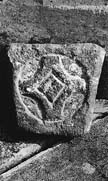Select a site alphabetically from the choices shown in the box below. Alternatively, browse sculptural examples using the Forward/Back buttons.
Chapters for this volume, along with copies of original in-text images, are available here.
Object type: Part of grave-marker
Measurements: H. 19 cm (7.5 in); W. 22 > 16 cm (8.7 > 6.3 in); D. 7 cm (2.8 in)
Stone type: Yellowish grey (10YR 8/3) oolite grainstone, with ooliths of a wide size range around 0.5mm (range 0.3 to 0.7mm), some 1mm to 2mm ovoid pellets and a very little shell detritus. Ancaster Freestone, Upper Lincolnshire Limestone, Inferior Oolite Group
Plate numbers in printed volume: Ills. 424–5
Corpus volume reference: Vol 5 p. 289
(There may be more views or larger images available for this item. Click on the thumbnail image to view.)
A fragment from the head end of a small marker decorated on both faces. The borders of both faces are edged with a chamfer.
A (broad): An incised 'lenticular' cross-head with a recessed central diamond (cf. Butler 1964, fig. 1E) .
B and D (narrow): Undecorated apart from the chamfer.
C (broad): A deeply incised A1 type cross composed of two intersecting grooves of V-section.
Appendix A item (stones dating from Saxo-Norman overlap period or of uncertain date).
This stone is included here because the simple A1 cross on face C is of the same type as those on Hough-on-the-Hill 3 (Ill. 399) and Lincoln St Mark 21 and 22 (Ills. 405, 406), for which a tenth- to thirteenth-century date has been suggested. The example from North Witham, however, occurs alongside the lenticular cross-head type which Butler dates to the first three-quarters of the twelfth century (1964, 117). It is even possible that the difference in quality between the precisely cut lenticular cross and the simple intersecting lines implies that the two motifs are of different dates, and if this is so, the simple cross on face C may be even later in date than the twelfth century.



